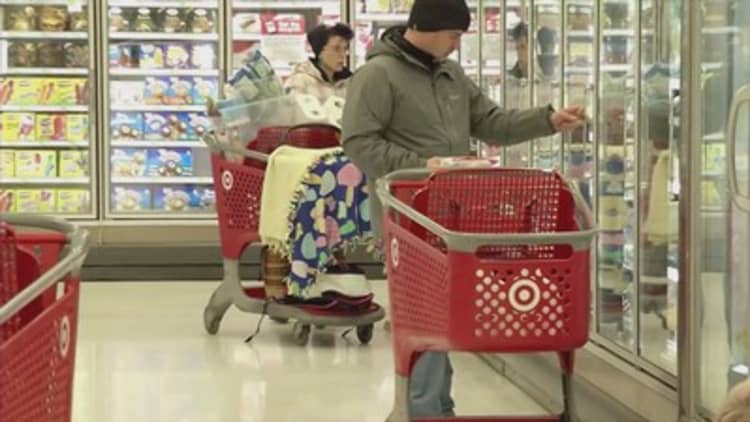
Downtown Manhattan residents who refuse to schlep all the way to Brooklyn, Harlem or Queens will now be able to shop at one of the country's largest retailers without hopping on the subway.
Target is cutting the ribbon Wednesday on its 45,000-square-foot Tribeca store, its latest effort to penetrate dense urban markets with smaller shops.
For New York City dwellers who haven't stepped foot inside a Target for awhile — and even for those who have — the Tribeca shop will look decidedly different.
Because it caters to urban living, the store will forego large furniture in favor of a full aisle of air mattresses. Instead of 24-packs of toilet paper meant for stocking up, visitors will be offered grab-and-go items from food to electronics.
And in place of your typical cookie-cutter food and beverage cafe, the Tribeca shop will be home to the Chobani yogurt company's second cafe.
"It's the best of what Target has to offer," spokeswoman Kristy Welker told CNBC on a store tour.
The two-level shop, just a five-minute walk from the World Trade Center area, is Target's 27th small store. By year's end, the company will operate 32 of these pint-sized locations. And while they still represent less than 2 percent of the big-box retailer's store count, they could eventually number in the hundreds, CEO Brian Cornell has said.
Each of these stores caters to the local markets they serve. In addition to the city-skewed merchandise at the Tribeca location, it will be the first Target store to feature overhead digital screens that direct shoppers to the next open checkout counter. That will help it handle the influx of traffic it expects.
The Tribeca shop will likewise be staffed by some 200 employees — a level that's more in line with its typical 135,000-square-foot stores, management said. By comparison, its 21,000-square-foot space that opened in Queens in July has roughly 70 employees.
Though Target declined to provide traffic or sales forecasts for the store, it's located smack in the middle of New York City's new downtown. Roughly 60,000 residents live in the area, and have a median household income of $134,756, according to the Alliance for Downtown New York.
The retailer is also catering to the nearly 15 million tourists expected to visit the area in 2017, Welker said.
As it learns what shoppers want from their local Target store, the company will make adjustments to its merchandise and presentation, Rob DeMarino, Target's store team leader, said. For example, when visitors at Target's San Francisco shop kept asking for paper plates and cups to host office parties, the retailer was able to get them in stock in a few weeks.
"That's the most exciting part," DeMarino said.
New York City is one of the 11 markets Target is focusing on for its small-store expansion. Other cities include Chicago, Philadelphia and Los Angeles. Among other stores it's slated to open are a downtown Brooklyn shop scheduled for this winter, and an East Village shop coming summer 2018.
Target does not break out the sales or profitability of its small shops as compared with its traditional locations, preferring to view its stores as "one Target," spokeswoman Molly Snyder said. She did say, however, that its small stores tend to receive more frequent footfall than its larger stores, and ring up higher sales per square foot.
Those sales certainly come at a cost. Though Target declined to share specifics regarding its Tribeca lease, ground floor space in lower Manhattan cost an average $294 per square foot as of the second quarter, according to CBRE data.
Yet Target's small shops shouldn't be viewed in a one-dimensional lens, Moody's analyst Charlie O'Shea cautioned. Instead, they're a way for Target to extend its brand into a new market, and build a relationship with new, existing or lapsed customers.
They also serve as another touch point in its advantage over Amazon: Having physical stores. At the entrance to Tribeca's store, for example, is a service desk where shoppers can pick up or return online orders.
"Target needs this second format," O'Shea said, adding that if retailers want to compete in both the digital world, they've "got to have more nimble bricks-and-mortar" operations.
In the fiscal second quarter, Target's comparable sales fell 1.1 percent, as it reported its first traffic decline in a year and a half.
Like Target, Wal-Mart is also rolling out a breed of smaller shops, called Neighborhood Market. These 668 stores average roughly 40,000 square feet.


